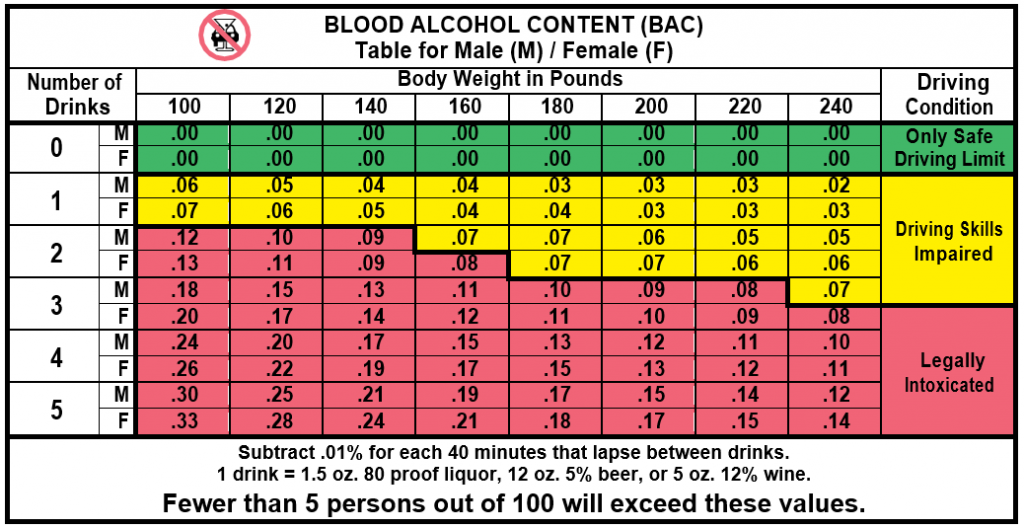Blood Alcohol Level Chart
Blood alcohol content (BAC) charts are compiled using medical and scientific information. They are used to estimate the concentration of alcohol in a person's blood. BAC charts from different companies will have minor differences, but they generally give similar information on a person's intoxication level based on the amount of alcohol they have consumed.
Washington alcohol servers should be familiar with appropriate BAC levels and how to use this chart to judge a customer's level of intoxication. Although a BAC chart is helpful in determining whether to continue serving alcohol to a customer, it should not be the primary tool in this important decision.

Source: California DMV
What Is Blood Alcohol Content?
Blood alcohol content, also known as blood alcohol concentration or blood alcohol level, is the percentage of alcohol present in the bloodstream. Beverages such as beer, wine and hard liquor contain different percentages of alcohol, which can contribute to a person's overall BAC.
Understanding BAC and the standard drink sizes can help you gauge safe levels of consumption for your customers.
According to the National Institute on Alcohol Abuse and Alcoholism, a standard drink typically contains about 14 grams of alcohol. Alcohol percentages vary based on the type of beverage.
One standard drink is equivalent to:
- 12 ounces of beer (about 5% alcohol)
- 1.5 ounces of liquor (about 40% alcohol)
- 5 ounces of wine (about 12% alcohol)
The liver can only metabolize about one standard drink per hour, which affects blood alcohol content.
The BAC chart works best when you can be sure the customer has not consumed any alcohol prior to your serving them — however, it is still a good reference in determining possible BAC levels.
What Affects BAC?
Factors to consider when serving alcohol include:
- The customer's current BAC. If the customer enters the establishment and appears to have already been drinking, servers should not allow them to have more alcohol. Employees who serve obviously intoxicated persons may be liable for alcohol-related damages or accidents, drunk driving and more.
- Signs of obvious intoxication. Glassy eyes, loss of balance, slurred speech, drinking too fast and nodding off at the table are some examples of intoxication.
- Weight. A person with a lower weight is more likely to get drunk faster than someone who is heavier.
- Type of drink. Someone who is drinking hard liquor (vodka, whiskey, tequila) is likely to have a higher BAC than someone drinking beer or wine.
- Age. Because the enzymes that break down alcohol slow with age, older people are generally prone to having a higher BAC than younger people.
Overall, it's important to use your best judgment when serving alcohol. If a person appears intoxicated (bloodshot eyes, slurred speech, aggression), stop serving them. Continuing to serve an intoxicated person or a minor can result in liabilities, fines and in some cases, jail time.
Dram Shop Laws
Dram shop laws are third-party liability laws that hold alcohol servers responsible for the actions of intoxicated persons and minors under 21 years old. Promoting responsible drinking — such as ceasing to serve intoxicated people and checking IDs to prevent underage sales — can lower the risk of alcohol-related incidents that could cause you to become liable.
Preventing Drunk Driving
Bartenders and other alcohol servers should be aware of intoxication signs and know when to stop serving alcohol. Recognizing signs of intoxication can help prevent drunk driving, reducing the risk of accidents and alcohol-related liability.
Stop serving alcohol to a person who is exhibiting the following traits:
- Watery, bloodshot eyes
- Slurred speech
- Aggressive behavior
- Trouble walking or staying balanced
- Falling asleep
Blood alcohol content can determine a person's ability to operate a vehicle. A person cannot legally drive a car if their blood alcohol level is 0.08 or higher. Driving skills are impaired by alcohol, so the only safe BAC level is 0.0. Being cognizant of your customers' BAC and level of intoxication helps prevent accidents, as well as individual and company liability.
